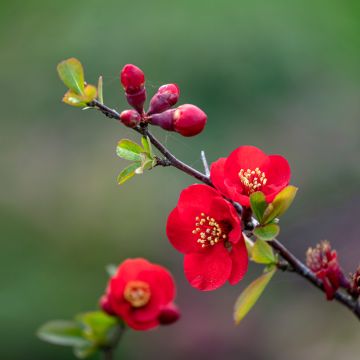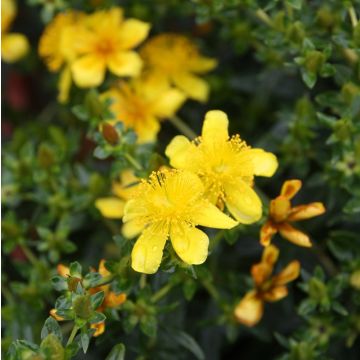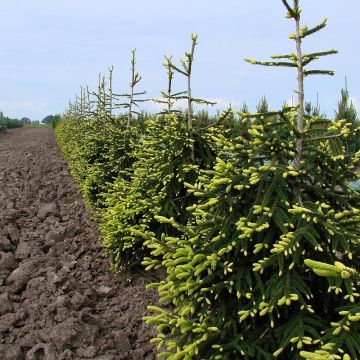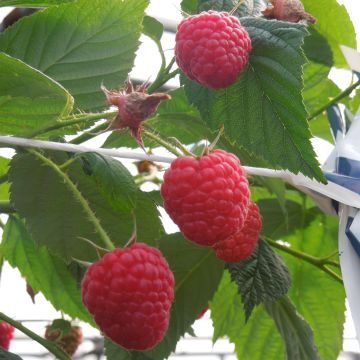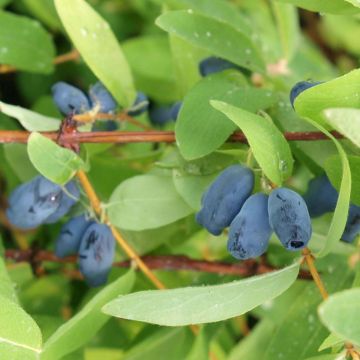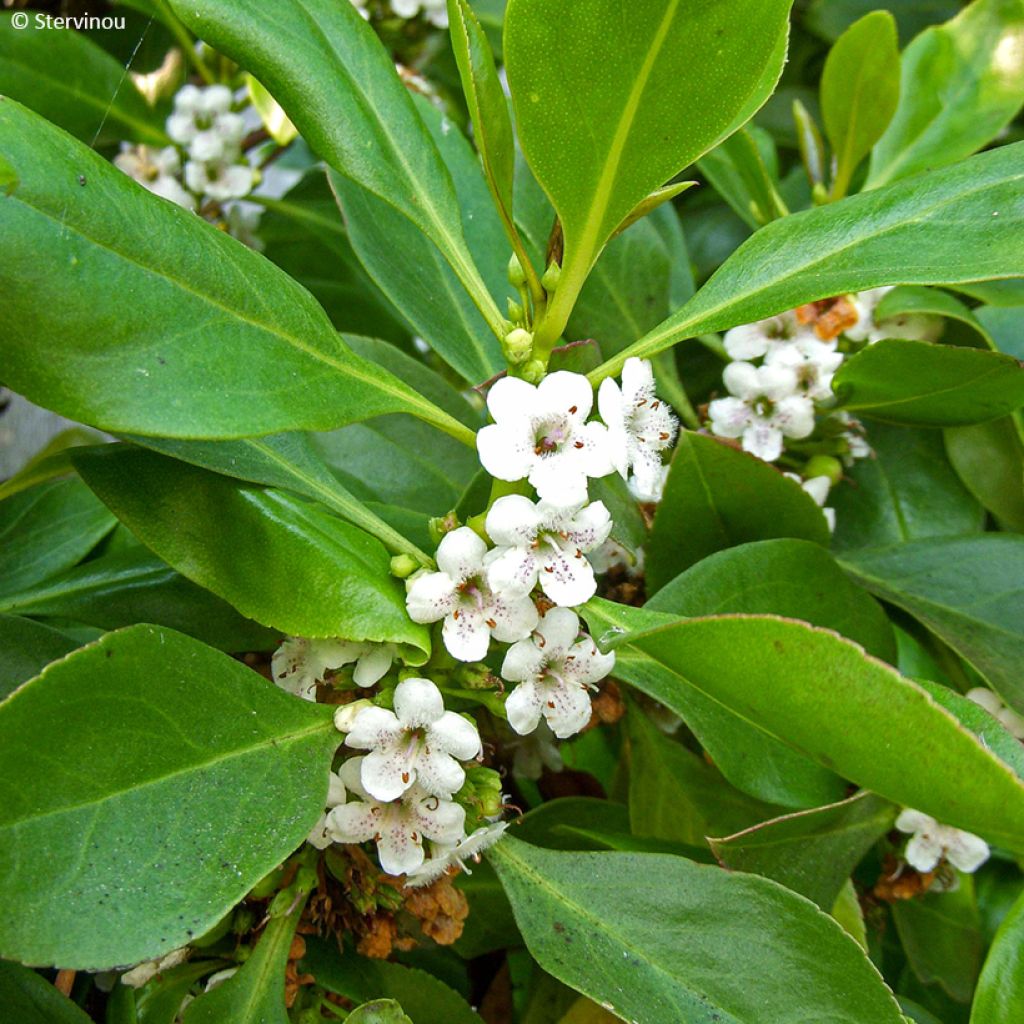

Myoporum laetum - Mousehole Tree
Myoporum laetum - Mousehole Tree
Myoporum laetum
Ngaio, Mousehole Tree, Myoporum
This item cannot be shipped to the selected country
Delivery charge from €5.90
Delivery to Corse prohibited
More information
Schedule delivery date,
and select date in basket
This plant carries a 24 months recovery warranty
More information
We guarantee the quality of our plants for a full growing cycle, and will replace at our expense any plant that fails to recover under normal climatic and planting conditions.
From €5.90 for pickup delivery and €6.90 for home delivery
Express home delivery from €8.90.
Delivery to Corse prohibited: UE law prohibits the import of this plant from mainland France to Corse as part of the fight against Xylella fastidiosa. Please accept our sincere apologies.
More information
Does this plant fit my garden?
Set up your Plantfit profile →
Description
The Myoporum laetum, also known as the bright myoporum, is a large bush or small evergreen tree native to New Zealand. Appreciated for its dense habit, elegant foliage, and rapid growth, it is often used to create windbreak hedges or as an ornamental shrub in New Zealand gardens. In our latitudes, it adapts well to coastal areas. It can also be grown in a pot in colder climates where it will be brought indoors in winter.
The Myoporum laetum belongs to the Scrophulariaceae family and comes from the coastal areas of New Zealand. In its natural habitat, it is found along the shores, where conditions are usually challenging for many plants. This large bush has a bushy and dense habit, reaching 3 to 6 m in height with a spread of 2 to 4 m. Its rapid growth is one of its main assets. Its evergreen leaves are dark green, elongated, measuring between 10 and 15 cm in length. Their smooth and shiny surface reflects light, which has earned this species its nickname of bright myoporum. Small white or pink flowers appear from May to July, clustered in the axils of the leaves. They emit a subtle fragrance, adding a delicate touch to its ornamental appeal. After flowering, small purple to black berries form, about 1 cm in diameter, but beware, they are toxic if ingested. The foliage is decorative throughout the year, even in winter. Thin and often flexible stems give the plant a light yet structured appearance.
The Myoporum laetum is interesting for creating hedges by the sea. It can be associated with sturdy shrubs like Pittosporum tobira, with its evergreen foliage and fragrant white flowers, Elaeagnus ebbingei, Olearia traversii and Griselinia littoralis which has thick and shiny leaves. These shrubs form a decorative, dense, evergreen, effective hedge capable of withstanding the harsh conditions of coastal areas in just a few years.
Report an error about the product description
Plant habit
Flowering
Foliage
Botanical data
Myoporum
laetum
Scrophulariaceae
Ngaio, Mousehole Tree, Myoporum
Myoporum tenuifolium, Myoporum crystallinum
Oceania
Other Shrubs A to Z
Planting and care
Planted in the ground, by the sea, the Myoporum laetum is planted in spring, in well-drained soil, preferably light and slightly sandy. Dig a hole twice as wide as the root ball, and incorporate compost or organic amendment if the soil is poor. It likes sunny locations but tolerates partial shade. Once planted, water regularly during the first year to promote root growth, but avoid excess water as it is sensitive to waterlogged soils. Once well established, it becomes drought-tolerant. Myoporum laetum prefers slightly acidic to neutral soils. It can adapt to slightly limestone soils (pH up to about 7.5), but it may show signs of chlorosis (yellowing of leaves) if the limestone content is too high.
Pot Culture:
Choose a large container with good drainage. A mix of soil for Mediterranean bushes or universal potting soil enriched with sand or perlite is recommended. Place the pot in full sun to maximise its growth. Water regularly, but allow the substrate surface to dry between waterings. In winter, protect it from frost by bringing it into a cold greenhouse or conservatory if temperatures drop too low. Fertilise in spring with a balanced fertiliser to support its growth, and prune lightly after flowering to maintain a compact shape.
Planting period
Intended location
Care
This item has not been reviewed yet - be the first to leave a review about it.
Hedge shrubs
Haven't found what you were looking for?
Hardiness is the lowest winter temperature a plant can endure without suffering serious damage or even dying. However, hardiness is affected by location (a sheltered area, such as a patio), protection (winter cover) and soil type (hardiness is improved by well-drained soil).

Photo Sharing Terms & Conditions
In order to encourage gardeners to interact and share their experiences, Promesse de fleurs offers various media enabling content to be uploaded onto its Site - in particular via the ‘Photo sharing’ module.
The User agrees to refrain from:
- Posting any content that is illegal, prejudicial, insulting, racist, inciteful to hatred, revisionist, contrary to public decency, that infringes on privacy or on the privacy rights of third parties, in particular the publicity rights of persons and goods, intellectual property rights, or the right to privacy.
- Submitting content on behalf of a third party;
- Impersonate the identity of a third party and/or publish any personal information about a third party;
In general, the User undertakes to refrain from any unethical behaviour.
All Content (in particular text, comments, files, images, photos, videos, creative works, etc.), which may be subject to property or intellectual property rights, image or other private rights, shall remain the property of the User, subject to the limited rights granted by the terms of the licence granted by Promesse de fleurs as stated below. Users are at liberty to publish or not to publish such Content on the Site, notably via the ‘Photo Sharing’ facility, and accept that this Content shall be made public and freely accessible, notably on the Internet.
Users further acknowledge, undertake to have ,and guarantee that they hold all necessary rights and permissions to publish such material on the Site, in particular with regard to the legislation in force pertaining to any privacy, property, intellectual property, image, or contractual rights, or rights of any other nature. By publishing such Content on the Site, Users acknowledge accepting full liability as publishers of the Content within the meaning of the law, and grant Promesse de fleurs, free of charge, an inclusive, worldwide licence for the said Content for the entire duration of its publication, including all reproduction, representation, up/downloading, displaying, performing, transmission, and storage rights.
Users also grant permission for their name to be linked to the Content and accept that this link may not always be made available.
By engaging in posting material, Users consent to their Content becoming automatically accessible on the Internet, in particular on other sites and/or blogs and/or web pages of the Promesse de fleurs site, including in particular social pages and the Promesse de fleurs catalogue.
Users may secure the removal of entrusted content free of charge by issuing a simple request via our contact form.
The flowering period indicated on our website applies to countries and regions located in USDA zone 8 (France, the United Kingdom, Ireland, the Netherlands, etc.)
It will vary according to where you live:
- In zones 9 to 10 (Italy, Spain, Greece, etc.), flowering will occur about 2 to 4 weeks earlier.
- In zones 6 to 7 (Germany, Poland, Slovenia, and lower mountainous regions), flowering will be delayed by 2 to 3 weeks.
- In zone 5 (Central Europe, Scandinavia), blooming will be delayed by 3 to 5 weeks.
In temperate climates, pruning of spring-flowering shrubs (forsythia, spireas, etc.) should be done just after flowering.
Pruning of summer-flowering shrubs (Indian Lilac, Perovskia, etc.) can be done in winter or spring.
In cold regions as well as with frost-sensitive plants, avoid pruning too early when severe frosts may still occur.
The planting period indicated on our website applies to countries and regions located in USDA zone 8 (France, United Kingdom, Ireland, Netherlands).
It will vary according to where you live:
- In Mediterranean zones (Marseille, Madrid, Milan, etc.), autumn and winter are the best planting periods.
- In continental zones (Strasbourg, Munich, Vienna, etc.), delay planting by 2 to 3 weeks in spring and bring it forward by 2 to 4 weeks in autumn.
- In mountainous regions (the Alps, Pyrenees, Carpathians, etc.), it is best to plant in late spring (May-June) or late summer (August-September).
The harvesting period indicated on our website applies to countries and regions in USDA zone 8 (France, England, Ireland, the Netherlands).
In colder areas (Scandinavia, Poland, Austria...) fruit and vegetable harvests are likely to be delayed by 3-4 weeks.
In warmer areas (Italy, Spain, Greece, etc.), harvesting will probably take place earlier, depending on weather conditions.
The sowing periods indicated on our website apply to countries and regions within USDA Zone 8 (France, UK, Ireland, Netherlands).
In colder areas (Scandinavia, Poland, Austria...), delay any outdoor sowing by 3-4 weeks, or sow under glass.
In warmer climes (Italy, Spain, Greece, etc.), bring outdoor sowing forward by a few weeks.

































